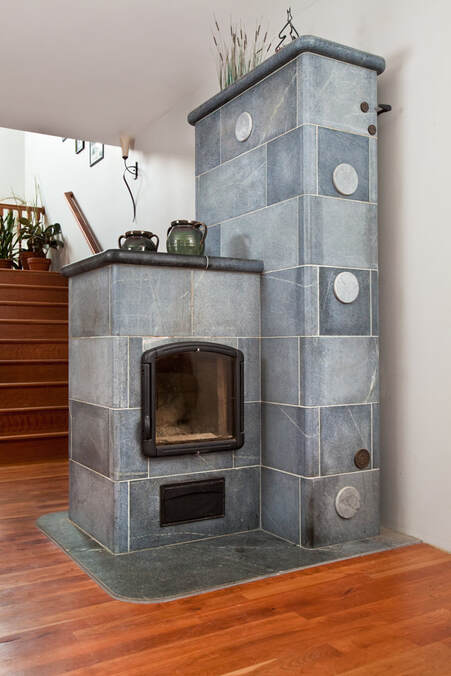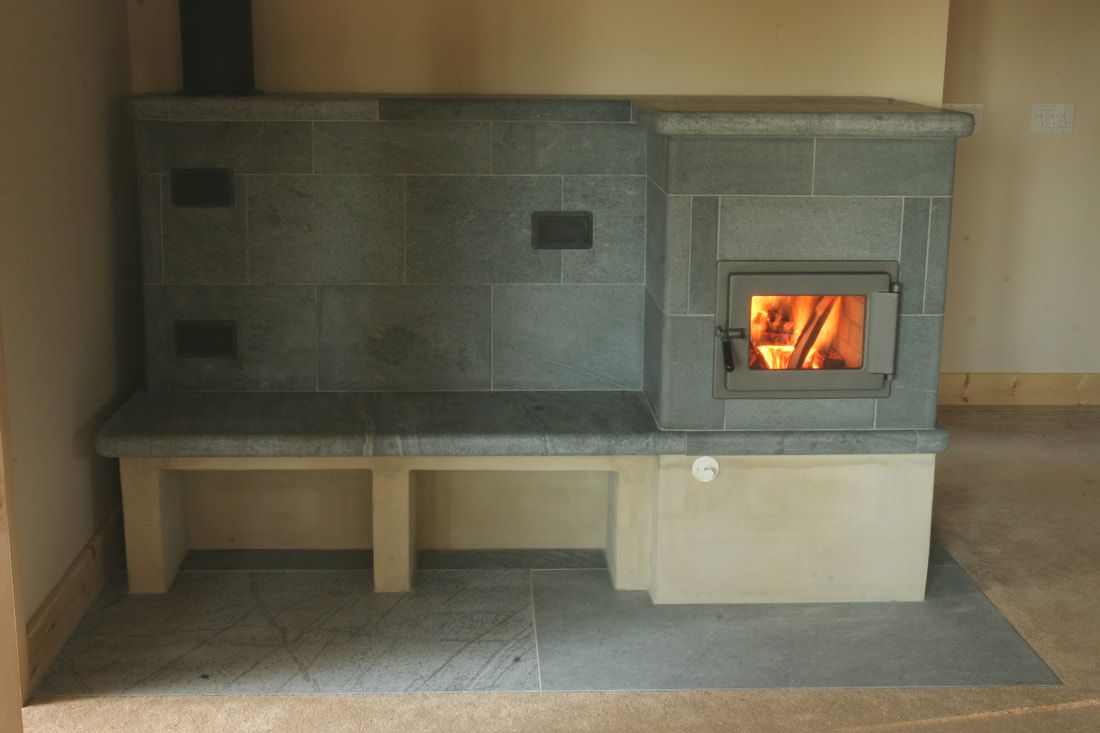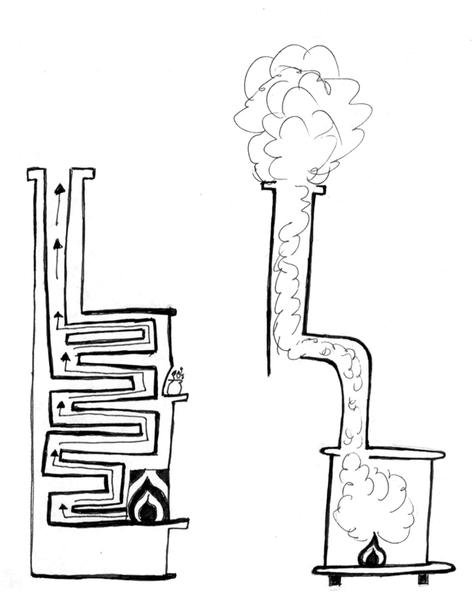What are Masonry Heaters?
Masonry heaters are heat storage and radiant systems that use wood fuel in a time-tested way. In contrast to fireplaces or wood-stoves that must be stoked frequently, and that warm only the people and things directly in front of them, a masonry heater warms an entire area with a hot, rapidly burning fire typically built once or twice a day. The intense heat and hot gases generated in the unit’s firebox are stored in the masonry body of the heater and released throughout the home. The larger the mass of masonry material, the more heat it can store. One fire lasting only about an hour can produce and store enough heat to last a day.
Masonry heaters appeal to all types of consumers through their varying designs and efficiency. The practical consumer can appreciate the unit’s fundamental simplicity. Masonry heaters don’t have blowers, fans, convectors, pipes, burners or boilers that can break, crack or fail when the power goes out; their mechanical reliability is unsurpassed. Others commission custom designs that take full advantage of the stone’s beauty and capacity to be fabricated into elegant designs that become architectural elements of the room. |
See What We've Been Up To
Benefits
Masonry heaters are an exceptionally clean way to use wood fuel. Because the fire in a masonry heater is short, hot and intense, it creates very little smoke & creosote. The intense heat of the fire consumes virtually all the fuel in the combustion chamber, so almost no dangerous creosote is produced to clog the chimney or run the risk of chimney fires. Residual ashes are dense, and easily removed from the heater’s ash collection container. Homes heated with masonry heaters stay cleaner and less dusty; walls and furniture don’t become smoke-stained.
Families with children and pets must exercise extra caution with traditional wood stoves because their metal surfaces can become hot enough to cause burns. Fireplaces can spew out stray sparks or flare up. A masonry heater’s surface is safe and comfortably warm and many masonry heaters incorporate built-in benches.
Families with children and pets must exercise extra caution with traditional wood stoves because their metal surfaces can become hot enough to cause burns. Fireplaces can spew out stray sparks or flare up. A masonry heater’s surface is safe and comfortably warm and many masonry heaters incorporate built-in benches.
History
Masonry heaters have been used in Europe and Asia for centuries, where they are still commonly found. Fuel to generate warmth has always been a precious commodity, and the attraction of a masonry heater is that it uses a minimum amount of fuel to produce a maximum amount of heat. Though it may seem counter-intuitive, the fire in a masonry heater is not kept burning continuously, but deliberately designed to burn down quickly. The stored heat in the masonry radiates warmth and maintains a comfortable temperature for hours.
Lifestyle Choice
Making the choice to heat your home with wood is gratifying for many reasons.
- Instead of buying oil, gas or electricity from a remote corporation and merely pressing a button or turning up a thermostat, you have chosen independence and a direct relationship with your source of heat.
- Making the fire creates a rhythm for the day and something to look forward to. It creates a moment of stillness as you watch the fire, helping wash away the stress and anxiety of the day.
- As the owner of a masonry heater you will reaffirm that choice every time you bring in a load of firewood, build a fire, sit back, and are rewarded by the beauty of the flames, the satisfying crackle and roar of a hot fire, and the immense feeling of comfort, warmth and security radiating from the massive stone hearth.
- The fire has been the gathering place for families and communities for generations upon generations. There is something inside us that is reminded of this simpler time in history as we share in the tradition of heating with wood.
How do I get one?
We design and build in accordance with your personal preferences and specifications for BTU output.
Get the exactly the heater you need. Options include bake ovens, benches, see-through fireplaces, and more.
You may select from soapstone, tile or stucco for the exterior masonry material. Pricing is per individual specifications.
Get the exactly the heater you need. Options include bake ovens, benches, see-through fireplaces, and more.
You may select from soapstone, tile or stucco for the exterior masonry material. Pricing is per individual specifications.
Rod puts the art in artisan, he talks with the client to see what is important to them, and to their home. He gathers information, and then interprets that into a personalized design. My intention was to build an environmentally sound and conscious home. We began with the heater, then discovered what Rod could do with soapstone counter tops. The counter tops are low maintenance and self-sustaining; because they offer a natural surface, they complement the rest of our home."
Sue
Litchfield, CT
Litchfield, CT
Requirements
Houses designed to accommodate a traditional masonry fireplace can be planned in the design phase or adapted to retrofit a masonry heater. They require sufficient structural support to accommodate their mass and are vented through standard masonry or metal insulated chimneys.
Each home is different.
Heating requirements vary greatly depending on layout, energy efficiency and other factors. An individual consultation will help determine whether you need a small, medium or large heater, and what sort of backup heating system, if any, your home will need. In especially large houses, two or three smaller heaters would heat more efficiently than one huge, wood-hungry heater, and could heat different areas selectively, as needed. Also, depending on your layout, the heater could be built to be fired from a utility room behind it; or the firebox and channels could be located in separate areas -- for example, the firebox in a basement which doesn't require heating, and the heat-exchange components up in the living area. A masonry bypass channel could also be built to direct heat into a room on another floor, or existing hot-air ducts could be used to circulate heat throughout the house. The possibilities are endless; your particular situation will dictate what is practical and desirable.
Heating requirements vary greatly depending on layout, energy efficiency and other factors. An individual consultation will help determine whether you need a small, medium or large heater, and what sort of backup heating system, if any, your home will need. In especially large houses, two or three smaller heaters would heat more efficiently than one huge, wood-hungry heater, and could heat different areas selectively, as needed. Also, depending on your layout, the heater could be built to be fired from a utility room behind it; or the firebox and channels could be located in separate areas -- for example, the firebox in a basement which doesn't require heating, and the heat-exchange components up in the living area. A masonry bypass channel could also be built to direct heat into a room on another floor, or existing hot-air ducts could be used to circulate heat throughout the house. The possibilities are endless; your particular situation will dictate what is practical and desirable.
Chimney and Foundation.
Your masonry heater will weigh anywhere between 2,000 and 10,000 pounds and requires a solid foundation. It is often cost-effective for the homeowner to have a local mason do the preparatory work during the building of a new home; New England Hearth & Soapstone will work closely with the mason to ensure the proper construction of the foundation. If an existing chimney will be used, it should be thoroughly inspected and cleaned, and its diameter measured for compatibility with the masonry heater's flue diameter; if the chimney is too large, it will reduce the draft necessary for proper burning and may need to be relined. The chimney (and indeed all places in the masonry heater system where ash and soot can collect) should have an easily accessible clean out door; a chimney cap is also a good idea. Installing a damper in the chimney flue above the heater will increase heat retention after a fire has gone out.
Your masonry heater will weigh anywhere between 2,000 and 10,000 pounds and requires a solid foundation. It is often cost-effective for the homeowner to have a local mason do the preparatory work during the building of a new home; New England Hearth & Soapstone will work closely with the mason to ensure the proper construction of the foundation. If an existing chimney will be used, it should be thoroughly inspected and cleaned, and its diameter measured for compatibility with the masonry heater's flue diameter; if the chimney is too large, it will reduce the draft necessary for proper burning and may need to be relined. The chimney (and indeed all places in the masonry heater system where ash and soot can collect) should have an easily accessible clean out door; a chimney cap is also a good idea. Installing a damper in the chimney flue above the heater will increase heat retention after a fire has gone out.
|
National Fire Protection Association.
National Fire Protection Association (NFPA) code requires that a chimney be a minimum of 2 feet above the highest point of the structure within 10 feet of the chimney; the minimum recommended chimney height is 18 feet. A centrally located chimney (totally within the house structure) is preferable to an exterior one, since it will ensure the best possible drafts: the house keeps the chimney warm, and the chimney keeps the house warm. |
Codes and Safety Requirements.
Different states have different codes regulating the construction of wood burning systems; in some, the code is based on the NFPA (National Fire Protection Association) Standard for Chimneys, Fireplaces, Vents and Solid Fuel Burning Appliances. The fact that masonry heaters are in a class by themselves, however, is increasingly recognized and progress in this area is ongoing.
Different states have different codes regulating the construction of wood burning systems; in some, the code is based on the NFPA (National Fire Protection Association) Standard for Chimneys, Fireplaces, Vents and Solid Fuel Burning Appliances. The fact that masonry heaters are in a class by themselves, however, is increasingly recognized and progress in this area is ongoing.
What About Cost?
In the short run, masonry heaters can cost twice to three times what a metal stove costs. But their high efficiency rate means you use between one-half and one-third less wood -- and you cut environmental pollution to an absolute minimum. In the long run, a masonry heater may pay for itself within three to five years, depending on fuel costs in your area, while providing a much more efficient, environmentally friendly form of heat for your family -- not to mention adding considerably to the value of your home. And while a masonry heater can actually cost about the same as a conventional open fireplace, with the masonry heater you will be heating your home -- not the air above it.
We're Not Just Blowing Hot Air.
There are many questions you may have when considering living with a Masonry Heater.
We're here to answer them.
We're here to answer them.




